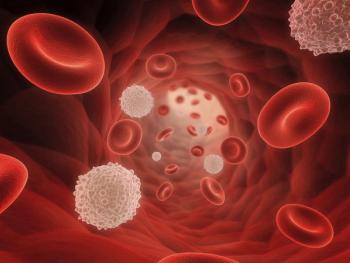
Camrelizumab/Famitinib Show First-Line PFS Benefit in Cervical Cancer
The confirmed ORR in the investigational arm was 52.3% vs 46.6% in the chemotherapy arm, with respective complete response rates of 10.9% and 8.5%.
Camrelizumab plus famitinib conferred a progression-free survival (PFS) benefit vs platinum-based chemotherapy as a first-line treatment among patients with recurrent or metastatic cervical cancer, according to a presentation of data from a phase 3 trial (NCT04906993) during the
At the June 10, 2025, data cutoff, at a median follow-up of 19.3 months (interquartile range [IQR], 13.9-26.8), the median progression-free survival (PFS) per blinded independent central review (BICR) was 11.1 months (95% CI, 8.4-13.6) in the combination arm (n = 220) compared with 7.5 months (95% CI, 6.3-8.3) in the chemotherapy arm (n = 223; stratified HR, 0.68; 95% CI, 0.53-0.86; P = .0007). The median PFS values per investigator assessment were 11.3 months (95% CI, 11.0-13.8) and 7.7 months (95% CI, 6.4-8.3), respectively (stratified HR,0.62; 95% CI, 0.49-0.79; P < .0001).
“The chemotherapy-free regimen of camrelizumab/famitinib significantly prolonged PFS and overall survival [OS] compared with platinum-based chemotherapy with/without bevacizumab [Avastin] as first-line treatment in recurrent/metastatic cervical cancer,” Xiaohua Wu, MD, PhD, chief physician, professor, and supervisor of oncology, as well as the chairman and chief expert in the Department of Gynecologic Oncology at Fudan University Shanghai Cancer Center in China, said during the presentation. “This regimen met the dual primary end points at interim analysis.”
How was the phase 3 trial designed and what were the baseline characteristics?
The open-label, controlled, multicenter study enrolled patients with histopathologically confirmed, recurrent or metastatic squamous cell carcinoma of the cervix.1,2 Patients were required to not be amenable to curative therapy, surgery, radiotherapy, or chemoradiotherapy and could not have received prior systemic therapy for recurrent or metastatic disease. Other key inclusion criteria included having at least 1 measurable tumor lesion according to RECIST 1.1 criteria and an ECOG performance status of 0 or 1.
Patients were randomly assigned 1:1 to receive intravenous (IV) camrelizumab at 200 mg every 3 weeks for up to 35 cycles plus oral famitinib at 20 mg daily, or platinum-based chemotherapy every 3 weeks for up to 6 cycles with or without IV bevacizumab at 15 mg/m2 every 3 weeks. Stratification was performed by PD-L1 combined positive score (CPS; ≥ 1 vs < 1) and prior use of platinum (yes vs no).
The dual primary end points were BICR-assessed PFS per RECIST 1.1 criteria and overall survival (OS).2 Secondary end points included investigator-assessed PFS, overall response rate (ORR), disease control rate (DCR), duration of response (DOR), time to response (TTR), and safety.
At baseline, the median ages in the combination and chemotherapy arms were 55.0 years (IQR, 50.5-59.5) and 54.0 years (IQR, 49.0-61.0), respectively.1 Most patients in these respective arms had a PD-L1 CPS of at least 1 (93.2% vs 92.8%), had metastatic disease (97.7% vs 97.3%), had received prior platinum-containing therapy (70.9% vs 70.0%), and had received prior therapy (95.5% vs 96.0%). At diagnosis, patients had stage I (15.9% vs 13.9%), II (32.7% vs 35.4%), III (38.2% vs 37.2%), IVA (0.5% vs 1.8%), IVB (8.2% vs 8.1%), or unknown (4.5% vs 3.6%) disease. Prior therapies included surgery (48.2% vs 44.8%), radiotherapy (85.5% vs 88.3%), and systemic anticancer treatment (86.8% vs 85.7%); 30.9% of patients in the chemotherapy arm received bevacizumab during the study.
What were the additional efficacy data and safety profile of the combination?
The median OS in the combination arm was 34.4 months (95% CI, 29.6-not reached) compared with 23.4 months (95% CI, 19.5-28.2) in the chemotherapy arm (stratified HR, 0.65; 95% CI, 0.49-0.86; P = .0012). Findings from a subgroup analysis revealed that the PFS benefit in favor of the combination arm was reported in all prespecified subgroups except for the subgroup of patients with a PD-L1 CPS of less than 1 (HR, 1.62; 95% CI, 0.72-3.68). The OS benefit with the combination was reported in all prespecified subgroups.
The BICR-assessed confirmed ORR in the combination arm was 52.3% (95% CI, 45.5%-59.0%) vs 46.6% (range, 39.9%-53.4%) in the chemotherapy arm, including respective complete response rates of 10.9% and 8.5%. The confirmed DCRs were 81.8% (95% CI, 76.1%-86.7%) and 77.6% (range, 71.5%-82.9%), respectively. The median DORs were 17.9 months (95% CI, 12.5-22.9) and 8.3 months (95% CI, 6.3-9.0), respectively, and the respective median TTRs were 2.2 months (IQR, 2.1-4.2) and 2.1 months (IQR, 2.1-2.2).
In terms of safety, any-grade treatment-emergent adverse effects (AEs) occurred in 99.5% of patients in the combination arm and 99.1% of patients in the chemotherapy arm. Patients in both arms experienced grade 3 to 5 treatment-related AEs (TRAEs; 87.3% vs 67.1%), serious TRAEs (34.5% vs 19.2%), as well as TRAEs leading to treatment discontinuation (13.6% vs 6.6%), dose interruption (83.6% vs 37.6%), and dose reduction (65.0% vs 12.2%). Patients in the combination arm experienced any-grade immune-related (38.2%) and grade 3 to 5 immune-related (7.3%) TRAEs; no such events were reported in the chemotherapy arm.
The most common any-grade TRAEs in the combination arm included decreased white blood cell count (79.5%), decreased neutrophil count (75.0%), and anemia (70.0%). These were also the most common any-grade TRAEs in the chemotherapy arm, occurring at respective rates of 73.7%, 70.0%, and 75.6%.
“The safety profile was manageable. These study findings [show that] camrelizumab plus famitinib could serve as a novel first-line treatment option for this patient population,” Wu said in his conclusion.
Disclosures: Wu reported no relevant disclosures.
References
- Wu X, Xia L, Wang J, et al. Phase 3 study of camrelizumab plus famitinib versus platinum-based chemotherapy as first-line therapy for recurrent or metastatic cervical cancer. Presented at: 2025 ESMO Congress; October 17-25, 2025; Berlin, Germany. Abstract LBA38.
- Camrelizumab combined with famitinib malate for treatment of recurrent/metastatic cervical cancer. ClinicalTrials.gov. Updated September 9, 2025. Accessed October 20, 2025. https://www.clinicaltrials.gov/study/NCT04906993
Newsletter
Stay up to date on recent advances in the multidisciplinary approach to cancer.

















































































